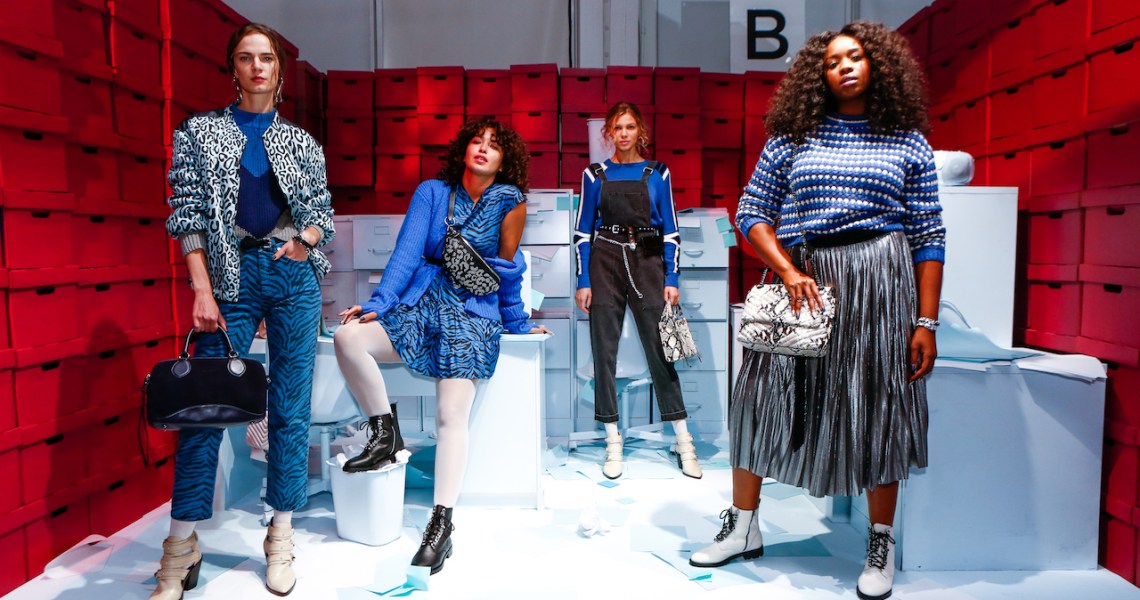In this week’s Glossy+ Briefing, Rebecca Minkoff rolls out her loyalty program, announced last year, while luxury brands embracing pop-ups and drops come out on top.
Rebecca Minkoff launches a loyalty program based on customer data
Fashion and beauty companies are increasingly launching loyalty programs, giving consumers a reason to shop one brand or retailer over another, repeatedly. It’s worked wonders for Sephora.
On Wednesday morning, Rebecca Minkoff sent an email to customers announcing a new loyalty program, RM Rewards — technically a phase two of a program set up last year. (A prior version, RM Squad, only provided discounts to members on their birthday.)
Shoppers can earn points five ways: by signing up for the program (usually 50 points, but 100 if they sign up in October), by making a Rebecca Minkoff purchase (1 point per dollar spent), by adding a second item to an order or transaction (25 points), by following the brand on Instagram (where it has around 885,000 followers; 25 points) and by providing a review of a product on rebeccaminkoff.com (25 points). Every 10 points earned gives the member $1 to spend with Rebecca Minkoff; for example, they’d need 980 points to buy a $98 pair of sunglasses.
Shoppers who have created an account on rebeccaminkoff.com — allowing them to create wishlists and also giving them personalized recommendations and quicker checkout due to saved payment information — are automatically grandfathered into the program.
In May 2018, Rebecca Minkoff announced through a press release a new loyalty program created with customer data and marketing platform Clutch. The plan was to roll out the program in two phases. The first allowed customers to learn about and enroll in the program, and earn points, while giving Clutch time to analyze their shopping behavior to eventually fine-tune the program’s components accordingly. This week marks the second stage: Features have been established, based on members’ wants and needs, and members can now use points they’ve earned. E-commerce marketing platform Yotpo is managing the membership and all involved operations.
At the Glossy Forum on Oct. 10, Rebecca Minkoff said that her company’s willingness to experiment has made it a draw for vendors looking to leverage work with a large, established brand. When Rebecca Minkoff switched from an older platform to Shopify, for example, Shopify earned many new customers as a result.
Ad position: web_incontent_pos1
“We’re fortunate in that we have tons of companies coming to us knowing that we’ll try stuff, and knowing that we’re OK with failure and that we can help work the kinks out of their platform,” she said. “So we negotiate. And [internally] we work as a team to decide what we want to try, based on what’s going to be the next thing to delight and help our customer, and eliminate the pain points of the shopping experience.”
Minkoff said, looking forward, the company is looking to spend less on Instagram and Facebook, particularly as it pinpoints effective alternatives for acquiring customers, including less-costly Instagram Stories and also video. At the same time, it’s ramping up strategies to build closer relationships with its audience. Since last year, it’s launched a podcast and a newsletter hosted and written by Rebecca Minkoff, respectively.
A loyalty program will help with that relationship, driving customers to shop direct with the brand rather than a retail partner. Department stores are, after all, still notorious for keeping customer data on lock.
“As you grow and scale, you need to rely on analytics and data for everything,” said Minkoff.
Top luxury brands are embracing rarity, not exclusivity
It’s the 17th of the month, which luxury fashion diehards know is B Series day, as established by Burberry after Riccardo Tisci’s buzzy appointment as creative director. Once a month, on the 17th, the brand drops a capsule collection, exclusively available to purchase on Burberry’s social media platforms, including Instagram and WeChat. Today, the release is a khaki-colored scarf intarsia-knit with “Burberry” in rainbow letters.
Ad position: web_incontent_pos2
Drops, of course, started in the sneaker industry. But luxury brands have been hijacking the model, and it’s working to their advantage.
On Thursday, brand consultancy Interbrand released the 20th edition of its annual Best Global Brands report, ranking 100 companies based on their financial performance, their role in impacting consumer purchasing behavior and their brand strength. Fifteen brands from the retail and luxury category made the list, including Louis Vuitton (No. 17), Gucci (33) and Burberry (96) — brands that, in recent years, have increasingly come down to earth. Gucci was the fastest-growing luxury brand of the year, with Interbrand giving it a brand value of $16.4 billion, up 23% from last year.
Luxury brands that have fallen off Interbrand’s list in recent years include Bulgari, Armani and Ralph Lauren. Other categories in the report include travel, technology and automotive.
Rebecca Robins, Interbrand’s global chief learning and culture officer, said the brands excelling in the current retail landscape are those leading with a hyper-personal, “obsessed” strategy, in their approach to both internal and consumer relationships.
“Great brands have always begun and grown strong from within,” she said. And today, strong internal teams know how to use customer data to the brand’s advantage.
For example, rather than opening a flagship in a fashion capital, they’re opening spaces that are based on where engaged consumers live, and remain focused on facilitating conversations and community. They’re short-lived pop-ups, and, often, products they’re selling are exclusive to those stores.
“It’s the new forms of rarity that are resonating for luxury consumers,” said Robins, noting that luxury is the overall fastest-growing brand sector. “We saw it with Riccardo Tisci’s B Series. And with Virgil Abloh’s playful, open, collaborative Louis Vuitton pop-up in New York. It’s about the experience of buying something curated, at one point in time, in a space that’s maybe not even made for retail.”




